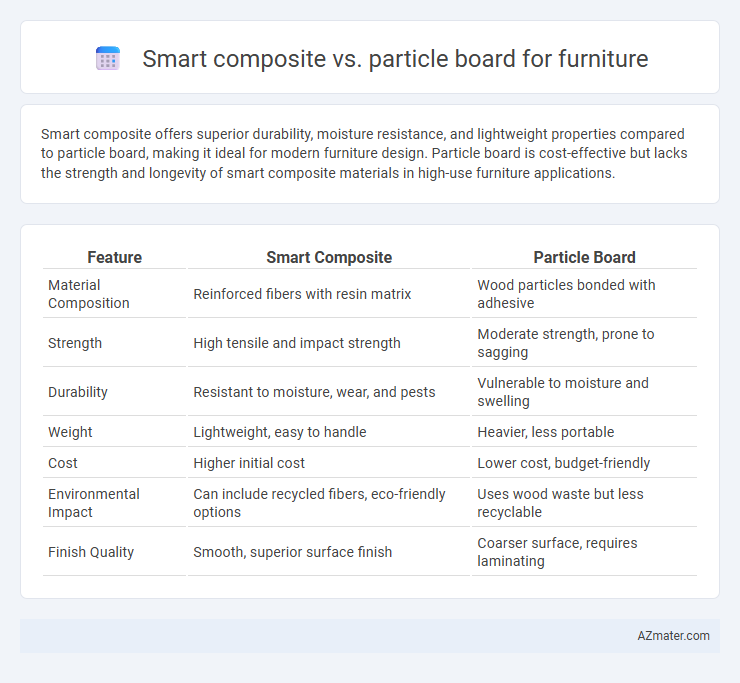Smart composite offers superior durability, moisture resistance, and lightweight properties compared to particle board, making it ideal for modern furniture design. Particle board is cost-effective but lacks the strength and longevity of smart composite materials in high-use furniture applications.
Table of Comparison
| Feature | Smart Composite | Particle Board |
|---|---|---|
| Material Composition | Reinforced fibers with resin matrix | Wood particles bonded with adhesive |
| Strength | High tensile and impact strength | Moderate strength, prone to sagging |
| Durability | Resistant to moisture, wear, and pests | Vulnerable to moisture and swelling |
| Weight | Lightweight, easy to handle | Heavier, less portable |
| Cost | Higher initial cost | Lower cost, budget-friendly |
| Environmental Impact | Can include recycled fibers, eco-friendly options | Uses wood waste but less recyclable |
| Finish Quality | Smooth, superior surface finish | Coarser surface, requires laminating |
Introduction to Smart Composite and Particle Board
Smart composite materials consist of engineered layers combining fibers and resins to enhance strength, durability, and moisture resistance, making them ideal for modern furniture applications. Particle board is manufactured from wood chips, sawdust, and resin pressed together, offering affordability and a smooth surface but lower durability and moisture resistance compared to smart composites. The advanced properties of smart composites support longer-lasting, lightweight furniture, whereas particle board remains a cost-effective option for budget-conscious designs.
Material Composition and Structure
Smart composite furniture combines advanced materials such as cellulose fibers, resins, and polymers, resulting in a lightweight yet durable structure with enhanced resistance to moisture and impact. Particle board consists of wood chips and resin bonded under heat and pressure, offering cost-effective but less durable and moisture-resistant qualities. The intricate layering and binding agents in smart composites provide superior structural integrity compared to the brittle and less dense composition of particle board.
Strength and Durability Comparison
Smart composites exhibit superior strength and durability compared to particle board, owing to their advanced fiber-reinforced matrices and higher density materials. While particle board is prone to swelling, warping, and reduced load-bearing capacity under moisture exposure, smart composites maintain structural integrity and resist deformation over time. This makes smart composite furniture ideal for high-stress applications requiring long-lasting performance and impact resistance.
Environmental Impact and Sustainability
Smart composite furniture offers enhanced sustainability due to its use of recycled or eco-friendly materials, lower emissions during production, and improved durability which extends product lifespan compared to particle board. Particle board often relies on synthetic resins and formaldehyde-based adhesives that contribute to higher indoor air pollution and limited recyclability. Choosing smart composites reduces landfill waste and supports eco-conscious manufacturing practices essential for sustainable furniture solutions.
Cost Effectiveness and Affordability
Smart composite offers higher durability and moisture resistance compared to particle board, making it a more cost-effective choice in the long term despite a higher upfront price. Particle board is more affordable initially but tends to degrade faster under stress and moisture, leading to increased maintenance or replacement costs. Choosing smart composite reduces overall expenses by enhancing furniture longevity and minimizing repairs.
Aesthetic Versatility and Design Options
Smart composite materials offer superior aesthetic versatility compared to particle board, allowing for sleek finishes and a variety of textures that enhance modern furniture design. Particle board, often limited by its uniform density and tendency to chip, restricts the range of customizable styles and intricate detailing. Manufacturers prefer smart composites for their adaptability to complex shapes and vibrant color options, making them ideal for innovative, high-end furniture pieces.
Workability and Ease of Fabrication
Smart composite materials offer superior workability compared to particle board due to their enhanced structural integrity and consistent surface quality, enabling precise cutting, shaping, and finishing. Particle board, while cost-effective, often poses challenges such as susceptibility to moisture damage and difficulty in achieving smooth edges, limiting its ease of fabrication. The advanced resilience and dimensional stability of smart composites make them ideal for complex furniture designs requiring high durability and refined aesthetics.
Moisture and Termite Resistance
Smart composite materials exhibit superior moisture resistance compared to particle board, making them ideal for furniture in humid environments. Particle board tends to absorb moisture, leading to swelling and potential structural damage over time, while smart composites use advanced resins and waterproof coatings to maintain integrity. In terms of termite resistance, smart composites incorporate termite-repellent additives or synthetic fibers, offering enhanced protection, whereas particle board's organic wood particles are more susceptible to termite infestation.
Ideal Applications in Furniture Design
Smart composite materials excel in modern furniture design due to their high strength-to-weight ratio and moisture resistance, making them ideal for ergonomic office furniture and outdoor pieces. Particle board, being cost-effective and easy to finish, suits budget-friendly applications such as flat-pack furniture and interior shelving. The choice depends on durability requirements, exposure to environmental factors, and desired aesthetic quality in the furniture project.
Conclusion: Choosing the Best Material
Smart composite furniture offers superior durability, moisture resistance, and environmental benefits compared to particle board, making it ideal for long-term use and modern interior designs. Particle board remains budget-friendly and suitable for lightweight applications but lacks the strength and longevity of smart composites. Selecting the best material depends on prioritizing factors like durability, cost, and aesthetic requirements for specific furniture projects.

Infographic: Smart composite vs Particle board for Furniture
 azmater.com
azmater.com